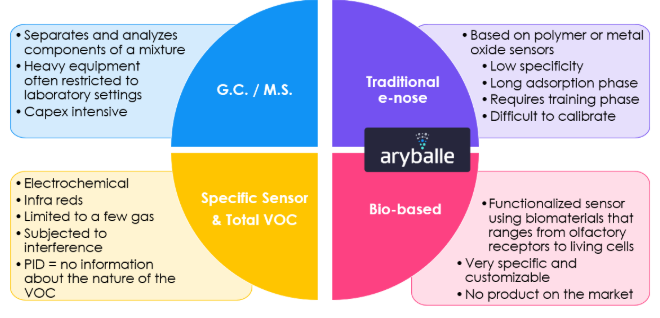OUR TECHNOLOGY
Advanced Sensing for Odor and VOC Detection
Aryballe has developed a unique and patented technology that mimics the human sense of smell through the combination of silicon photonics and peptide-based sensors. This powerful platform delivers fast, reliable, and integrable odor recognition across a wide range of applications.
Our Core Technology
At the heart of Aryballe’s innovation is a silicon chip composed of 64 Mach-Zehnder interferometers, each coated with custom peptides designed to selectively bind with volatile organic compounds (VOCs). These interactions generate a distinct olfactory signature for each substance—analyzable in real time.
How Aryballe Stands Out
Miniaturized & Easy to Integrate
Our sensor chip is compact and robust, making it ideal for integration into diverse devices and systems.
Rapid & Repeatable Measurements
Optimized for industrial workflows, our sensors deliver consistent results with fast response and regeneration.
AI-Powered Data Interpretation
Advanced machine learning algorithms analyze complex sensor outputs to provide actionable insights, enabling reliable pass/fail decisions and detailed investigations.
Scalable Production
All sensors are produced in-house in our ISO 7 cleanroom using an 8” wafer-level process, ensuring quality, scalability, and control.
Internal Manufacturing Capabilities
Aryballe’s state-of-the-art cleanroom (built in 2021) supports the entire sensor lifecycle—from chemical functionalization to validation and production. With a capacity of up to 1 million sensors per year, we ensure industrial-grade performance and traceability.
Why Aryballe’s Sensing Technology
In recent years, various sensor technologies have been developed to analyze VOCs and odors for use in quality control, safety monitoring, and product development. While solutions such as metal oxide semiconductor (MOS) sensors and optical gas sensors have gained traction, they face notable limitations in reliability, sensitivity, and selectivity. At Aryballe, we’ve engineered a fundamentally different approach—one that overcomes the weaknesses of traditional systems and sets a new standard for gas and odor sensing.

Want to learn more
If you would like more information about our digital olfaction technology and how it can help your organization, please contact us.

